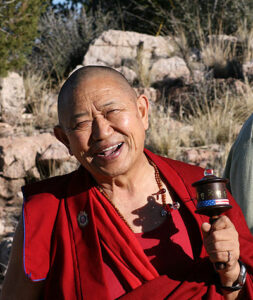Three (3) Yanas
The three levels (vehicles) of the path are combined into a single essential point and are practiced together. They are not separate from one another and are not distinct from the path. The precepts of Pratimoksha or Hinayana and the principles of Bodhisattva of Mahayana are the essential practice foundation for those individuals who wish to enter Vajrayana. The Buddha taught the various dharma in accordance with the mental capacities and inclinations of sentient beings. This should be, however, understood to be the progression of the practice of an individual and not to refer to different types of dharma.
The purpose of all dharma is bodhicitta, and the essence of the dharma is to transform and purify the mind of self-grasping. Bodhicitta is the preliminary and is the actual main part of the practice. Depending on one’s past karma, fortune and merits from past lives, one has a certain mental capacity, inclination and aspiration to develop a state of mind and engage in the corresponding practice as it naturally arises as a result of virtue and merits accumulated.
According to the Pratimoksha or Hinayana path, one wants to be liberated from suffering, thus first recognize the faults of the afflictions, then must abandon the afflictions, and thereby strives to attain liberation for oneself. This state of mind is somewhat limited, because all the Buddhas of the three times develop the mind of enlightenment – that is the altruistic mind thinking “I will benefit all sentient beings for as long as sentient beings exist until they all have attained enlightenment.” This state of mind is called the mind generation of the Mahayana. And based on this motivation, one comes to the bodhisattva path where one transforms the afflictions by cultivating love and compassion. When one cultivates love and compassion deeper and deeper, then the afflictions will naturally become the six paramitas, on which basis one understands and enters the Vajrayana. In Vajrayana, afflictive emotions are taken as the path in which the afflictions are liberated naturally into the natural state of the mind, just like ice dissolving into water. One practices to simply see the empty nature of the afflictions without rejecting, avoiding or transforming them. The nature state of the mind dissolves and completely dissipates the afflictions.
Vajrayana method is just like to combine the mundane world and the spiritual system together in which ones does not need to abandon the worldly life but where one can still attain the state of liberation. Essentially, Vajrayana is a path of pure perception where one perceives as pure not only oneself but also all others and all phenomena that appear. An individual who really understands Vajrayana sees everything and everyone as pure – simply because all beings possess the very same Buddha nature. Whether or not one places ordinary habitual imprints of samsara into one’s mind, depends on whether or not a perception of self is present. When there is no self-grasping, then all of these habitual tendencies along with all karmas and suffering are dissipated. That is the essence of all Vajrayana practices!
In short, the ultimate result of the Pratimoksha or Hinayana, Bodhisattva and Vajrayana vehicles comes down to the practice of the view, meditation and conduct.



